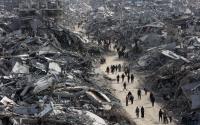31 August 2005The Independent
A semi-submerged New Orleans had in effect ceased to function last night, as America struggled to come to grips with the devastating onslaught of Hurricane Katrina. The storm has probably killed hundreds of people, and laid waste a 150-mile stretch of the US central Gulf coastline in what may be the greatest national disaster in modern US history.
Yesterday Katrina's remnants brought drenching rains, high winds and killer tornados to a swath of the central US as the system moved to the north-east. But sections of Louisiana, Mississippi and Alabama may remain virtual ghost lands for weeks or longer, populated by expanses of debris, downed trees and crumpled homes.
Nowhere is more stricken than New Orleans, most of which lies below sea level. At first the city seemed to have dodged the worst of the storm. But overnight one of its protective levees buckled beneath the weight of water from nearby Lake Pontchartrain and broke open in two places.
At least four-fifths of New Orleans is under water, in some places 10ft deep or more. With hundreds, if not thousands, of people still stranded in flooded homes, attics and rooftops across the city, rescue boats were bypassing the dead to reach the living, Mayor C Ray Nagin said. "We're not even dealing with dead bodies," Mayor Nagin said. "They're just pushing them on the side."
There is no electricity, no gas, virtually no telephone lines, no food arriving in the city, and almost no drinking water. To all intents and purposes the "Big Easy", beloved the world over, has ceased to function.
Before Katrina struck New Orleans with her 100mph-plus winds on Monday morning, 80 per cent of its inhabitants had heeded official advice to leave the city. Kathleen Blanco, Louisiana's governor, now says she is considering ordering a total evacuation. "Unfathomable and catastrophic," was how she described the situation, warning it will be "weeks and weeks" before people can come back.
New Orleans, in short, stands on the brink of the "apocalyse scenario" depicted by those who have long warned that its protective system of levees and canals was no match for a storm as powerful as Katrina. Stripped of its defences, they said, the city could be transformed by such a disaster into a giant basin of water with nowhere to escape, full of sewage, human and animal bodies and effluents from the chemical plants near the city, a breeding ground for mosquitoes and disease.
Barring a speedy reprieve, swaths of New Orleans may have to be rebuilt from scratch.
First, however, many of those who chose to stay have to be rescued. Yesterday afternoon helicopters and flat-bottomed boats picked up hundreds of people trapped on the roofs of their homes, now tiny islands in the muddy brown waters. Rescue operations were set to continue through the night. The famous Canal Street thoroughfare had become exactly that by the afternoon, as the water level continued to creep higher.
Last night army engineers were preparing to try to plug the breaches, one of them 200ft long. Only then can the city's pumping system itself apparently affected by the storm remove the standing water.
In the meantime the death toll looks set to mount. Officially, only 59 people are known to have lost their lives as a result of Katrina. But the final total seems bound to be many times higher. In the lagoon city of Biloxi and outskirts, an emergency mannagement official said the death toll had already exceeded 100. Thirty people perished in one incident alone, when a record 25ft storm surge swept away a beachside apartment complex.
"Our house split in half, it just opened up," said Harvey Jackson, a Biloxi resident who was in tears as he clutched his small son in a despairing search for his wife, Tonette, vanished in the calamity unleashed by the hurricane and winds reaching 140mph. "She was with me, but I can't find her. She's gone. I'm lost. I've lost all that I had."
Rescue teams, moreover, have only started to help smaller Gulf-coast communities to the north-east of New Orleans like Bay St Louis, where a mile-long bridge connecting it to the mainland was destroyed.
Along the coast, large boats were washed hundreds of yards inland, trailer trucks were picked up by the wind and water, great trees were uprooted and tossed around like matchsticks. In the Alabama gulf port of Mobile, the flooding was the worst since 1917. In Gulfport, Mississippi normally a bustling town of 71,000 people floodwaters stretched five miles inland.
The American Red Cross is mounting the largest relief effort in its history, while the Pentagon is sending National Guard units to tackle the flooding.
Michael Brown, director of FEMA, the federal government emergency relief agency, said it would be "weeks and weeks, if not months," before an approximation of normal life could resume.
Across the region, up to 1 million people were homeless, in effect refugees in their own country. Millions were without power. Officials in all three states affected pleaded with evacuees not to return to their homes, to allow emergency operations to proceed. In Louisiana, the I-10 interstate, the main east-west access to New Orleans, was closed 50 miles from the city.
President George Bush, who was cutting short his five-week Texas holiday to return to Washington today to monitor the crisis, delivered a similar message: People had to wait, "Our priority is saving lives." For the moment, his words are being heeded. But patience may not last long, in one of the poorest parts of the US, beaten down by a summer heat and humidity that the hurricane's downpours have made even worse.
Every sign is that this will be America's costliest natural disaster. Insured losses are estimated at anything up to $26bn (£14bn), eclipsing damage caused by Hurricane Andrew, the category 5 storm which struck the Miami area in August 1992. Non-insured damage from Katrina is unknown.
Indirectly, the effects will be felt by every American. A quarter of US domestic oil comes from Gulf oilfields, all but shut down by Katrina, while 25 per cent of all oil used in the US is refined in the region. Petrol prices already at record levels are likely to rise by 15 to 20 cents a gallon.
As for the shattered region itself, there is but one tiny, purely semantic, consolation. There cannot be another Katrina. Like Camille, Andrew, Hugo and other legendary storms of the past, her name will be retired into the Hurricane hall of fame, never to be used by America's weather services again.






